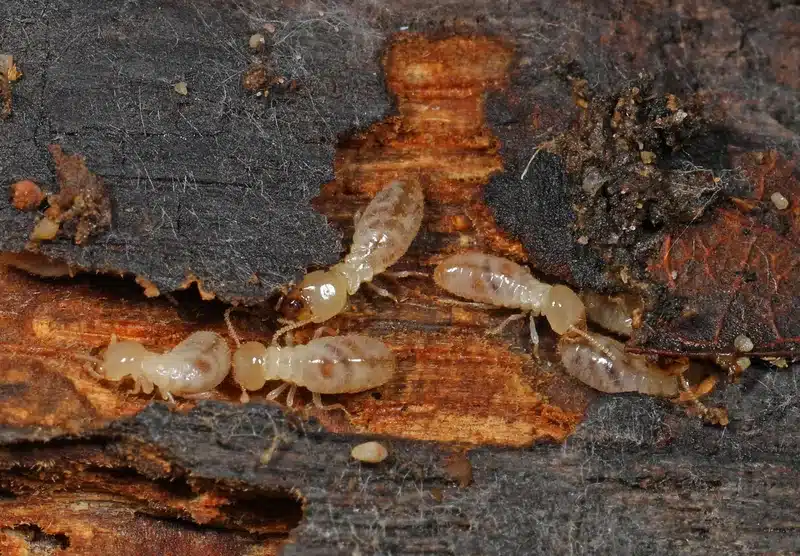Seeing a swarm of winged insects around your home can trigger immediate panic. Many homeowners worry they’ve discovered termites when they spot flying bugs near windows or doors. However, many bugs that look like flying termites are actually harmless. The key is knowing which ones require professional attention.
In my years helping homeowners with termite identification, I’ve seen countless cases where people assumed the worst. Sometimes they’re right to be concerned, but often these flying insects turn out to be something completely different. Understanding the difference can save you both stress and money.
What Are Flying Termites and What Do Termites Look Like?
Flying termites aren’t actually a separate species - they’re called alates or swarmers. These are reproductive termites that leave established colonies to start new ones. When you see them, it typically means there’s a mature colony nearby that’s been thriving for 3-7 years.
In the Virginia, Maryland, and DC area, termite swarms usually happen during daylight hours from March through May. They’re triggered by warm temperatures above 60°F combined with recent rainfall. These conditions create the perfect storm for reproductive termites to take flight.
How to Identify True Termite Swarmers
True termite swarmers have distinct characteristics:
- Straight antennae - No bends or elbows
- Two pairs of equal-length wings - Both sets are the same size
- Thick waists - No pinched appearance like you’d see on ants
- Translucent wings - They shed them quickly after swarming, leaving behind piles of identical wings on windowsills and in spider webs
Common Bugs That Look Like Flying Termites
Several insects can fool homeowners into thinking they have termites. According to the University of Maryland Extension, winged ants are the most common source of confusion.
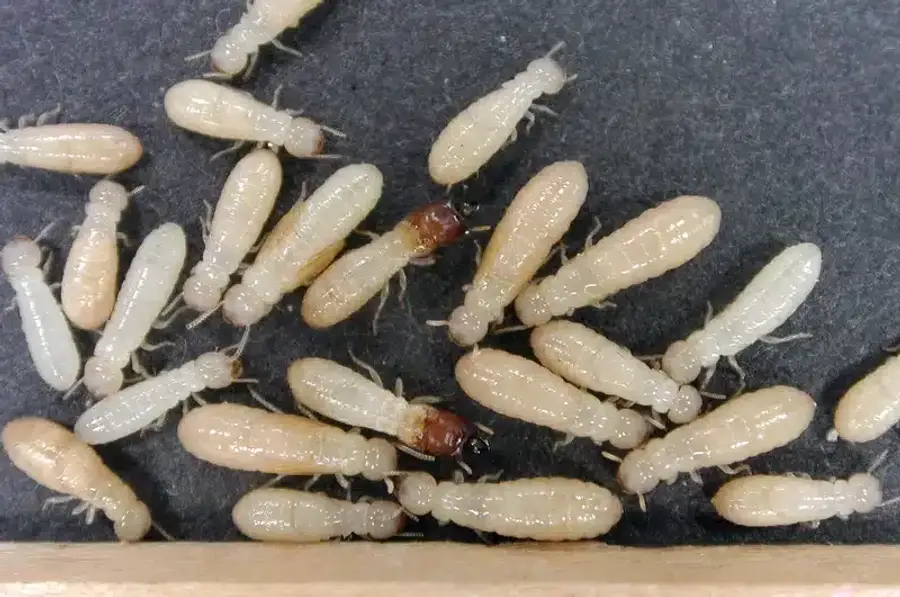
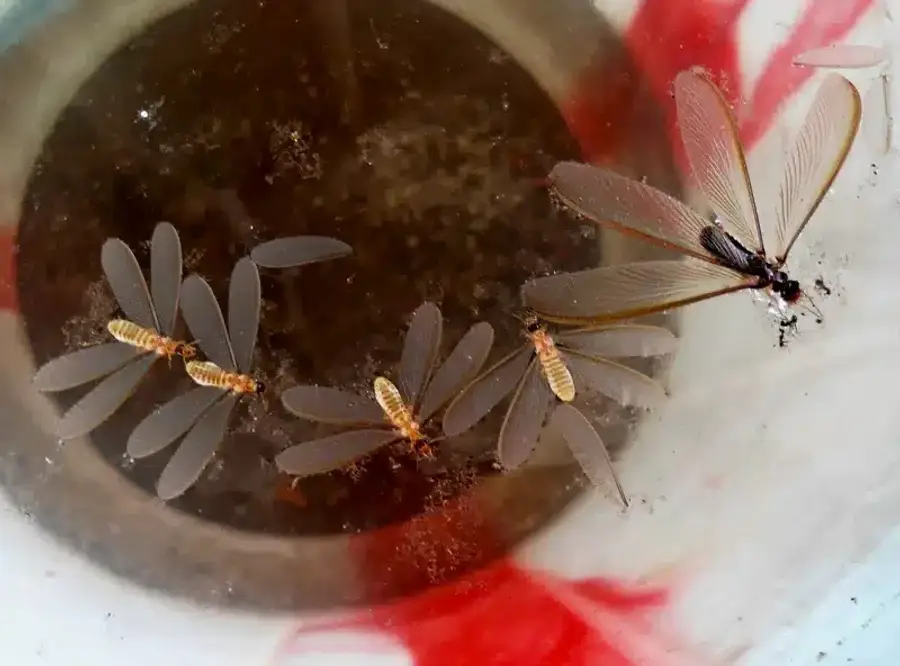
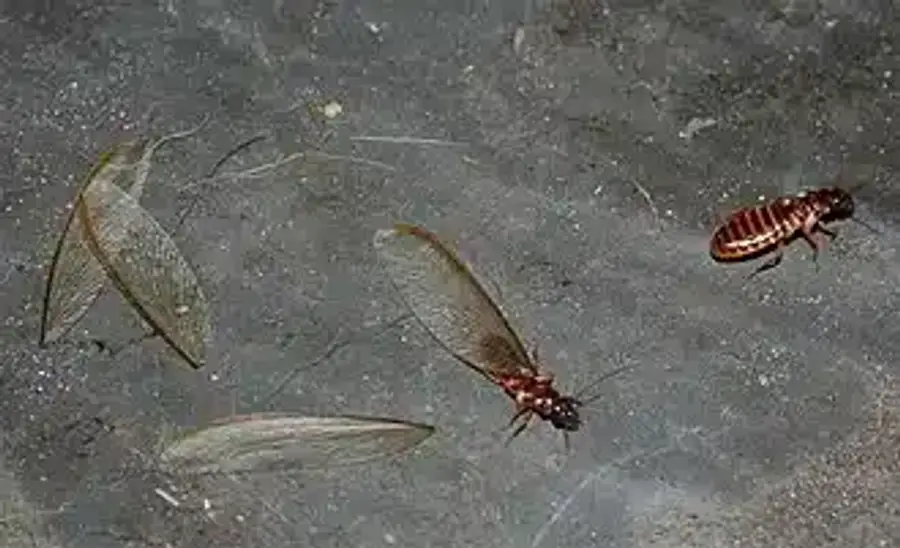


Flying ants have three key differences from termites: elbowed antennae, unequal wing pairs (front wings longer than back wings), and pronounced waist constriction. Carpenter ants, acrobat ants, and odorous house ants all produce spring swarmers that can appear indoors.
Mayflies emerge in massive synchronized hatches near rivers and lakes. While they shed equal wings like termites, they have distinctive long “tails” extending from their abdomens and don’t enter wood structures.
Wood cockroaches have slender brown bodies with wings that fold flat against their backs. Males are attracted to lights and may enter homes, but they don’t form galleries in wood like termites do.
Drywood termites are occasionally found in coastal areas but are much less common than subterranean species. They’re slightly larger and typically swarm in late summer or fall rather than spring.
How to Tell the Difference

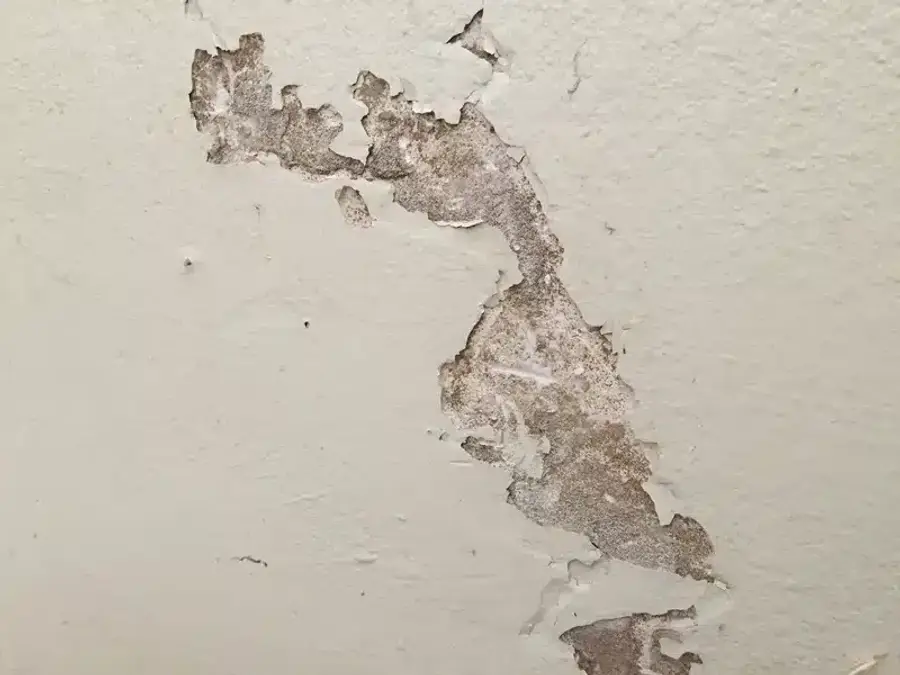


The easiest way to distinguish between bugs that look like flying termites is examining their antennae and wings. Termites have straight, beaded antennae that look like tiny strings of pearls. Ants have distinctly elbowed antennae with a clear bend.
Wing comparison is equally revealing. Termite wings are nearly identical in size and shape, with simple vein patterns. Ant wings have the front pair noticeably larger than the back pair, creating an uneven silhouette.
Body shape provides another clue. Termites maintain a relatively uniform width from head to tail, while ants have that characteristic “wasp waist” - a dramatic narrowing between the thorax and abdomen.
Behavior differences can also help with identification. Termites are poor fliers and tend to flutter weakly before landing and shedding their wings. Flying ants are more agile and may continue flying around light sources for extended periods.
Field Clues Beyond the Swarm
Even if you can’t identify the flying insects themselves, other evidence around your home tells the real story. Termite activity leaves distinct calling cards that harmless look-alikes simply don’t create.
Mud tubes are perhaps the most obvious sign. These pencil-width tunnels of soil and termite saliva extend from the ground to wooden structures, allowing termites to travel while staying protected from open air. You won’t find these with flying ants or mayflies.
Structural damage patterns also differ significantly. I remember one inspection in Alexandria where a small bulge in a window sill led us to discover extensive hidden damage - tunnels running up inside the crawl space and severely compromised beams. This type of systematic wood consumption is unique to termites.
Termite tunnels follow the grain of the wood and create hollow chambers that produce a distinct tapping sound. Other insects might chew wood, but they don’t create the same methodical gallery systems that termites do.
Regional Termite Profile in Virginia, Maryland and DC
The Eastern subterranean termite dominates our region and is responsible for essentially all structural infestations in Maryland and Virginia. This species has adapted perfectly to our Mid-Atlantic climate and soil conditions.
Less common species include other Reticulitermes varieties like R. virginicus and R. hageni. Occasionally, coastal areas see drywood termites (Incisitermes snyderi), but these are relatively rare compared to their subterranean cousins.
Climate change is bringing new concerns. Formosan subterranean termites, which are even more aggressive than our native species, have been found in isolated pockets of tidewater Virginia. Warming winters could allow this destructive species to establish permanent populations farther north.
Conditions That Invite Termites into Homes
Understanding what attracts termites helps distinguish real threats from harmless bugs that look like flying termites. Moisture and cellulose - basically wood - are the two things termites actively seek.
Mulch against your foundation creates an ideal termite buffet. It holds moisture and provides food, essentially rolling out a welcome mat for foraging termites. HVAC units and stumps near the house create thermal gradients that termites use for navigation, since they’re completely blind.
Earth-to-wood contact eliminates termites’ need to build exposed mud tubes. Deck posts touching soil, untreated steps, or siding at ground level give termites direct access to start feeding immediately.
Poor drainage around foundations, leaking pipes, and clogged gutters create the moisture-rich environment termites need to thrive. These conditions don’t attract flying ants or other look-alikes in the same way.
When to Worry About Bugs That Look Like Termites
Not every flying insect warrants immediate concern, but certain situations definitely require professional attention.
When to Call a Professional Immediately
Contact a professional if you notice:
- Indoor swarms - Termites don’t typically venture inside unless there’s an established colony very close by
- Piles of identical wings on windowsills, in corners, or caught in spider webs
- Multiple warning signs - Flying insects combined with mud tubes, moisture problems, or hollow-sounding wood
- Recurring swarms from the same location over multiple seasons - this almost certainly indicates an established termite colony
Finding piles of identical wings suggests termite activity. The EPA notes this wing-shedding behavior as a classic termite indicator that other insects don’t typically exhibit.
Why Professional Inspection Matters
From my experience helping over 100 customers with termite-related issues, I’ve learned that early detection makes all the difference. That Alexandria home I mentioned earlier could have avoided major structural repairs if the problem had been caught sooner.
Technical accuracy matters enormously when identifying bugs that look like flying termites. Many species require 10x magnification or microscopic examination to distinguish definitively. What might look like a flying ant to the untrained eye could actually be a termite swarmer.
Legal and real-estate considerations add another layer of complexity. Conventional, VA, and FHA loans typically require wood-destroying insect inspections on standardized forms like the NPMA-33. These inspections must be conducted by licensed professionals who understand both the insects and reporting requirements.
Soil-applied termiticides are EPA-restricted products that require special licensing and training. Misapplication can contaminate wells or living spaces, making DIY treatment both ineffective and potentially dangerous.
Professional Inspection and Reporting Standards
Better Termite’s 78-point inspection process examines every accessible area where termites might establish or travel. Licensed technicians check foundation perimeters, crawl spaces, basements, and structural wood throughout the home.
Maryland requires specific inspection standards documented in state regulations, while Virginia relies on industry guidelines and voluntary certification programs. In Virginia, choosing a VPMA-certified inspector ensures adherence to professional standards even without mandatory state licensing.
The inspection process involves visual observation, wood sounding, and probing accessible areas. Inspectors document inaccessible areas and create diagrams showing findings. The resulting NPMA-33 or MD-1 form provides a standardized report valid for 90 days in most lending scenarios.
Treatment Options for Termites
When bugs that look like flying termites turn out to be actual termites, several treatment approaches are available. Sentricon baiting systems work exceptionally well for proactive protection and early-stage infestations. These in-ground stations are extremely effective and environmentally conscious.
For more severe infestations where termites might not find monitoring stations, targeted liquid treatments using products like Premise or Termidor create protective barriers around foundations. This often involves trenching and may require drilling slabs or infected areas.
Termite bonds provide long-term protection through annual inspections and retreatment warranties. This proactive approach catches problems early before they become expensive repair situations.
In my experience, it’s almost always cheaper and less stressful to be proactive rather than reactive when it comes to termite protection.
Preventing Termite Infestations
These prevention strategies create an environment less conducive to termite establishment.
Annual professional inspections catch problems before they become major issues. Even with perfect maintenance, termites can find ways to access structures, making regular monitoring essential.
Emerging Issues in Termite Control
Climate change is extending termite swarm seasons and potentially allowing more aggressive species like Formosan termites to establish permanent populations farther north. This means homeowners need to stay vigilant for longer periods each year.
Green termiticides are becoming more prominent as homeowners seek environmentally conscious options. Products like Essentria, borate-based solutions, and biological controls offer effective protection with reduced environmental impact.
Our internal research team has eliminated 9 industry-standard chemicals that didn’t meet our criteria for use in family homes. This reflects a broader industry trend toward products that balance effectiveness with environmental and health considerations.
Debunking Common Myths
Several persistent myths about termites and bugs that look like flying termites can lead homeowners astray. “Brick houses can’t get termites” is completely false - termites attack the wooden framing inside brick veneer construction just as readily as any other home.
“One treatment lasts forever” is another dangerous misconception. Soil treatments degrade over time, and baiting systems require ongoing monitoring and maintenance to remain effective.
“If I don’t see mud tubes, I’m safe” ignores the reality that above-ground colonies can exploit hidden plumbing lines or other moisture sources without building visible tubes on exterior foundations.
Better Termite’s Research-Driven Approach
The Schulz family has been protecting Mid-Atlantic homes since 1968, now into our third generation of service. We’ve built an internal research team that reviews thousands of studies and product labels to ensure we’re using the most effective, least-risky options available.
We’ve eliminated 9 chemicals that are cleared for residential use but didn’t meet our standards for products we’d feel comfortable using in our own homes. This includes introducing alternatives like Essentria, Sentricon, and EcoVia that prioritize family and environmental wellbeing.
As a local, family-owned business, we understand that what we do affects our own community, kids, and pets. This drives us to constantly evaluate and improve our methods while maintaining the effectiveness our customers depend on.
Through decades of experience, including helping over 100 customers with termite situations, we’ve learned that education and proactive protection consistently deliver better outcomes than reactive treatment after damage occurs.
Frequently Asked Questions
Are flying ants the same as flying termites?
+
No, flying ants and termites are completely different insects. Flying ants have elbowed antennae, pinched waists, and unequal wing pairs, while termites have straight antennae, thick waists, and equal-length wings.
Why do I find piles of wings near my windows?
+
Piles of identical wings typically indicate termite swarming activity. Termite alates shed their wings shortly after flight, and these discarded wings often accumulate on windowsills or get caught in spider webs near swarm exit points.
When should I call a professional about bugs that look like flying termites?
+
Contact a professional if you spot swarms indoors, find mud tubes on your foundation, notice hollow-sounding wood, or discover piles of shed wings. Any combination of these signs warrants immediate professional inspection.
Can I treat bugs that look like flying termites myself?
+
While DIY traps might reduce nuisance pests, accurate identification requires expertise, and effective termite treatment uses EPA-restricted products that require professional licensing. [Professional treatment](/how-to-kill-termites/) is typically necessary for actual termite problems.
How often should I schedule termite inspections?
+
Annual inspections are recommended for most homes, with more frequent monitoring if you've had past termite issues, notice conducive conditions, or live in high-risk areas. [Regular inspections](/termite-inspection-virginia/) catch problems before they become expensive.
Do termites always build mud tubes?
+
No, termites can exploit hidden moisture sources like plumbing leaks or above-ground colonies without building visible exterior mud tubes. This is why comprehensive inspections examine crawl spaces and interior areas, not just foundation perimeters.
What time of year do bugs that look like flying termites appear?
+
Eastern subterranean termites typically swarm March through May during daylight hours after warm rains. Flying ants may swarm at various times, and other look-alikes like mayflies have their own seasonal patterns.
How quickly do termites cause damage after swarming?
+
Swarming indicates a mature colony that's been established for years. While new swarmers take time to establish additional colonies, the damage you're seeing likely represents years of feeding by the existing colony.
Can termite prevention eliminate the risk of seeing bugs that look like flying termites?
+
Prevention significantly reduces termite attraction but can't eliminate all insects that might be mistaken for termites. However, proper moisture control and exclusion methods will reduce overall pest pressure around your home.
What should I do if I captured some flying insects I think might be termites?
+
Preserve specimens in a small container or plastic bag for professional identification. [Professional inspection](/can-you-see-termites/) can determine the species and whether treatment is necessary, especially since many look-alikes are harmless.
With five years of hands-on experience in the pest control industry, George Schulz is a registered technician with the Virginia Pest Management Association and a proud third-generation professional in a family business that's been protecting homes for over 57 years. He manages and trains a team of service pros while also leading internal research efforts—recently spearheading a deep-dive review of thousands of documents on pest control materials to hand-pick the most kid and pet friendly, most effective solutions tailored specifically for homes in the DC metro area.
